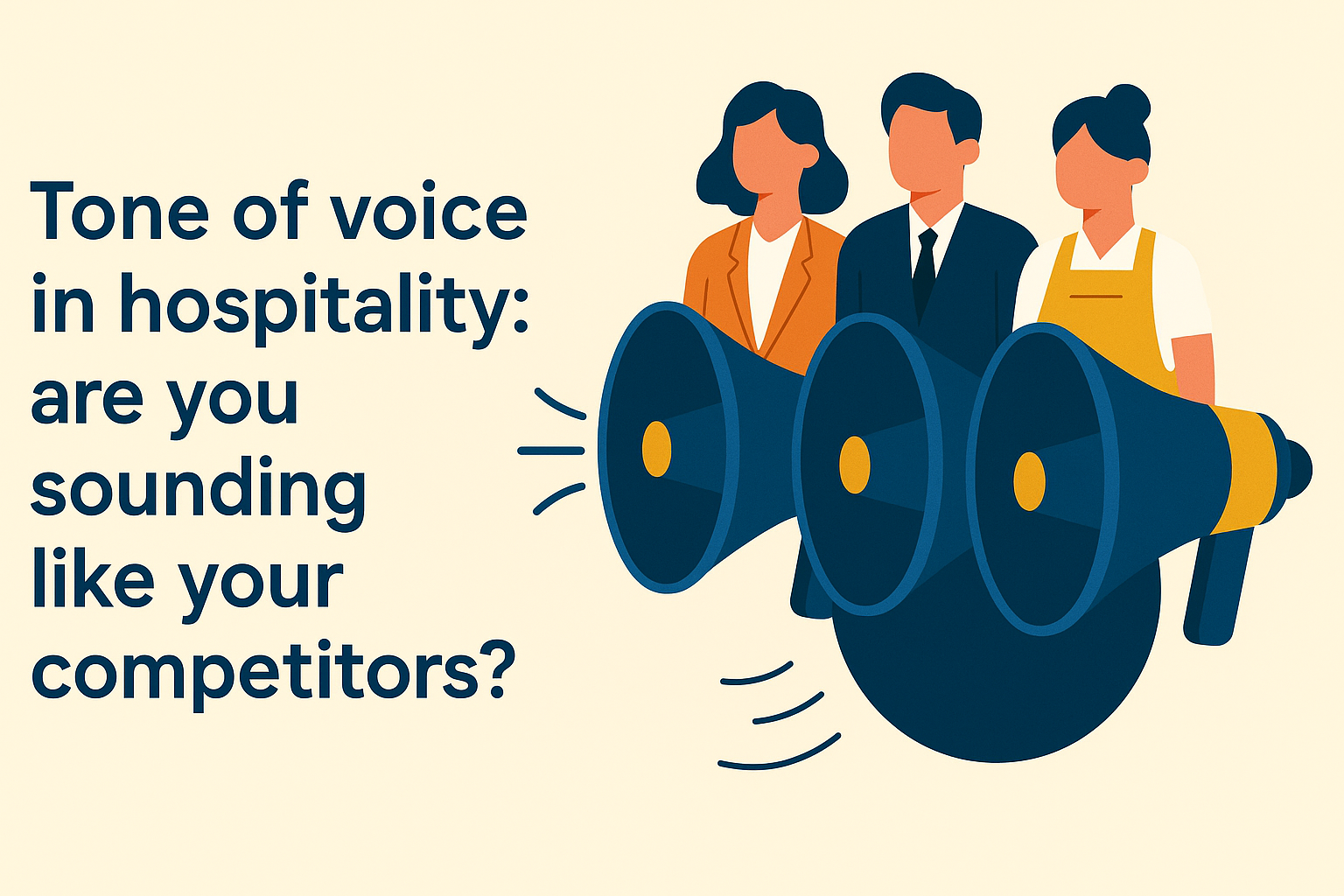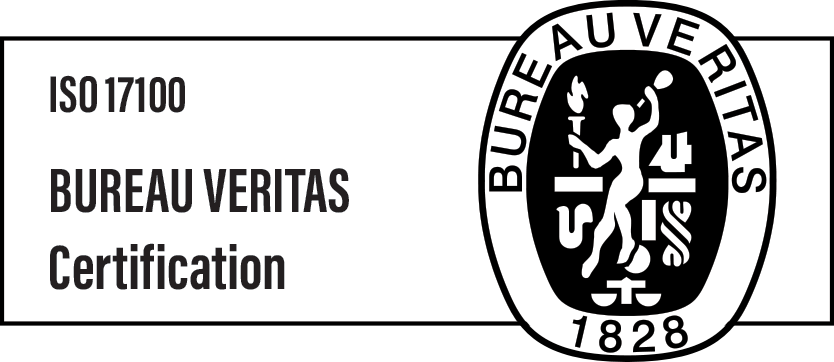Tone of voice in hospitality: are you sounding like your competitors?

Sounding nice isn’t the same as sounding unique
Visit a few hotel or restaurant websites and you’ll start to notice a trend. Many use the same warm, pleasant phrases: “we create unforgettable experiences,” “our guests are at the heart of everything we do,” or “escape the everyday with us.” None of it is wrong. But none of it stands out either.
In hospitality, tone of voice is often overlooked. Brands focus heavily on visuals, layout, or translation—but forget that the way they speak matters just as much as what they say. And in a saturated market, tone is one of the few tools that can help you connect emotionally and leave a lasting impression.
That doesn’t mean every brand has to sound quirky or edgy. But it does mean your voice should reflect your identity—your values, audience, and experience. The difference between “Check availability” and “Your next escape is one click away” is more than tone. It’s intention.
This article explores why tone of voice is essential in hospitality and how Language Service Providers (LSPs) can help you craft and scale it across every market you serve. If you want to move from generic to memorable, this is where to start.
1. Why tone matters more than ever in a saturated market
The hospitality industry is more crowded than ever. With so many options available online, guests have become more selective. They’re not just comparing amenities or prices—they’re reacting to how your brand makes them feel. And your tone of voice plays a major role in that first impression.
Your tone reflects your personality. It gives shape to your values. And it tells people not just what kind of business you are, but what kind of experience they can expect. Whether your brand is modern and sleek or charming and traditional, the way you speak should reinforce that feeling everywhere—on your homepage, in your booking flow, in your emails, and even on social media.
A well-developed tone helps your message feel human. It invites people in. More importantly, it builds trust and makes your communication recognizable. When you sound the same across platforms and in multiple languages, your brand becomes easier to remember—and easier to trust.
Language Service Providers can support this by identifying your natural tone and helping you express it consistently. They don’t just translate your content; they adapt the message to keep your voice intact, no matter the language or medium.
Tone is not fluff. It’s a strategic asset. And when done well, it quietly guides more guests toward booking with you instead of a competitor who sounds just like everyone else.

Why tone matters more than ever in a saturated market
2. Are you using a default voice without realizing it?
Many hospitality brands believe they already have a tone of voice. And technically, they do—just not one they’ve defined on purpose. Often, it’s a mix of inherited marketing templates, outdated phrasing, and safe-but-sterile language that blends into the background.
Take a look at your website. Are you saying what every other hotel says? “Relax in comfort,” “book your stay today,” “your home away from home”—these phrases may be friendly, but they’re also forgettable. If you replaced your brand name with a competitor’s, would anything sound different?
A weak or generic tone doesn’t actively hurt you—but it doesn’t help you either. It’s invisible. And in a competitive industry like hospitality, invisibility costs bookings.
A tone audit is often the first step in reclaiming your voice. It helps you uncover overused expressions, inconsistencies across channels, and missed opportunities to sound more like yourself. This isn’t just about being creative. It’s about being strategic. A boutique hotel in the Swiss Alps should not sound the same as a business hotel in downtown Madrid.
LSPs with tone-of-voice expertise can guide you through this process. They help you explore how your brand should sound, identify what makes it distinctive, and document it so your tone doesn’t get lost when content gets translated, repurposed, or rewritten.
If you haven’t decided how your brand should speak, someone else has decided it for you—probably your competitors.

Are you using a default voice without realizing it?
3. How to define your brand’s tone of voice—and document it
If you want your brand to sound unique, you have to start by defining what that means. Too often, tone is left to individual writers, marketing managers, or translators—none of whom are working from the same playbook. That’s where tone of voice documentation comes in.
The process starts by anchoring your voice in something real: your values, your mission, your audience. Ask yourself, how do you want guests to feel when they read your content? Inspired? Reassured? Curious? Then ask what kind of personality your brand would have if it were a person—formal or friendly, lively or calm, assertive or discreet?
Once you’ve answered these questions, it’s time to put it in writing. A good tone of voice guide includes voice traits (such as warm, confident, playful), practical do’s and don’ts, example phrases, and adjustments for different formats (e.g., social media vs. confirmation emails).
For brands operating in multiple languages, this isn’t just useful—it’s necessary. Without clear guidance, your tone risks being lost or diluted in translation.
This is where Language Service Providers add real value. Many offer tone workshops where brand, marketing, and content teams collaborate to shape a shared voice. The result is a document that empowers everyone—from copywriters to linguists—to write confidently and consistently.
When your brand voice is defined and documented, you’re no longer guessing. You’re creating with purpose.

How to define your brand’s tone of voice—and document it
4. Scaling your tone across languages without losing identity
A well-defined tone is only useful if it survives across languages. And that’s where many hospitality brands struggle. They invest in shaping a great voice in English, but when that content gets translated, something goes missing. The result is technically correct—but emotionally off.
This happens because traditional translation doesn’t always carry intent. It focuses on meaning, not feeling. So phrases that are witty, warm, or subtly persuasive in one language become bland or awkward in another. Over time, your voice becomes fragmented, even within the same website or campaign.
To avoid this, you need more than translation—you need adaptation. Skilled linguists trained in tone-of-voice strategy can replicate the emotional impact of your original content. That might mean changing sentence rhythm, swapping idioms, adjusting formality, or rethinking humor—whatever is needed to make the message feel natural in the new language.
Just as important is consistency. If your confirmation email feels upbeat in French but stiff in German, you create a disjointed experience. Your Language Service Provider can help with this by implementing tone-aligned review workflows, multilingual copywriting, and cross-market audits.
With the right support, you don’t have to choose between clarity and character. You can sound like yourself—in every language.

Scaling your tone across languages without losing identity
Your voice is your edge
When everything else feels equal—price, quality, service—it’s tone that sets brands apart. The way you speak to your guests builds trust, emotion, and identity. It turns a hotel into a host, a restaurant into a storyteller.
In today’s global market, that voice needs to travel. It needs to feel consistent across touchpoints and languages, while still resonating with local audiences. That’s not easy—but it’s possible.
A strong Language Service Provider doesn’t just translate. They help you define your voice, express it across cultures, and scale it with care. So your brand doesn’t just sound good—it sounds like you.
If your brand voice has gone quiet, now is the time to turn up the volume.

